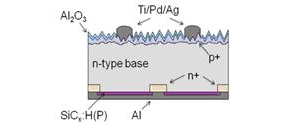The use of nanotechnology can greatly improve the photoelectric conversion efficiency of photovoltaics. The black battery developed by researchers at Aalto University in Finland through ALD and nanotechnology is a good example. Preparation of nanostructures is done by plasma etching, which can greatly impair the reflection of light. In addition, an appropriate passivation layer can be prepared by ALD to reduce the carrier recombination of the surface layer.
"Nano-structured black cells work very well and actually reduce the reflection of the full spectrum," said Hele Savin, assistant professor of micro and nano sciences at Aalto University, in the report. "The surface prepared by the ALD method has a very good surface passivation effect. The surface recombination rate of the black battery is similar to that of the flat surface and the pyramid surface," she said. Both reflectance and passivation are taken into account at the same time, and there is almost no difference between black silicon and ALD in the use of polycrystalline and single crystals.

Although Salvin believes that the use of this technology in future silicon-based batteries is still somewhat premature, she still hopes that this technology can greatly improve the photoelectric conversion efficiency. , And it is commercial use of large size.
Salvin's team is also working on other projects at the same time, such as using low-purity silicon materials to make high-efficiency cells, which is usually considered impossible. She said: "We have now discovered some ways to recycle waste silicon materials to make solar cells. The problem now being researched is that the purity of discarded silicon materials should be industrially controllable and require flexibility. "If this research is successfully commercialized, it will certainly bring about a significant drop in the cost of solar cells.
When asked about when a commercial nanostructured black battery came out, optimistic Salvin said: The prototype of the battery has been completed in the laboratory, the next step is to study how to make large-scale manufacturing, and look at the module size and outdoor test. She said: "In theory, there is no special limitation to commercialization. The cost of manufacturing nanostructures is a key point." On the other hand, when nanostructures are used to reduce reflections, conventional anti-reflection preparation methods are usually thought of. This just offsets the cost of preparing nanostructures.
There is still an unsolved problem: Salvin currently uses sulphur hexafluoride to make nanostructures. However, sulfur hexafluoride (Sulfur Hexafluoride) is a restricted-use gas that is generally not allowed to be directly discharged into the atmosphere. They are currently trying to use new technologies to circumvent such a problem and thus do not pollute the environment.
Cement Grinding Aid is a kind of chemical additives can improve cement grinding effect and performance, can significantly improve the cement production, every period cement strength, were to improve its liquidity.Cement grinding aid can greatly reduce the grinding ball phenomenon formed in the process of electrostatic adsorption package, and can reduce the grinding of ultrafine particles in the process of coalescence trend again.Cement grinding aid can significantly improve the liquidity of cement and improve the mill grinding effect and efficiency of classifier choose powder, so as to reduce the energy consumption of grinding.Using Grinding Agent in the production of cement with a low compaction trend of coalescence, which benefits the loading and unloading of cement, and can reduce the phenomenon of wall hanging cement silo.As a kind of chemical additives, grinding agent can improve the cement particle distribution and hydration, so as to improve the early strength cement and later strength.
Cement Grinding Aids,Grinding Agent,Cement Additives,Grinding Aid
NINGBO LUCKY CHEMICAL INDUSTRY CO. LTD , http://www.chinaluckychem.com
